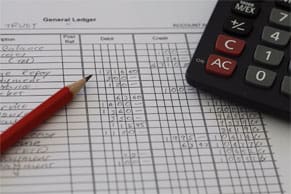Accounts receivable and accounts payable are the yin and yang of business: When revenues and expenditures stay in healthy equilibrium, the company can seize growth opportunities, and relationships with customers and suppliers remain on a positive footing.
A company's accounts payable (AP) ledger lists its short-term liabilities —obligations for items purchased from suppliers, for example, and money owed to creditors. Accounts receivable (AR) are funds the company expects to receive from customers and partners. AR is listed as a current asset on the balance sheet.
Lenders and potential investors look at AP and AR to gauge a company's financial health. Income is important, and so is prudent spending to grow the business and retain customers. Mismanagement of either side of the equation can adversely affect your credit and, eventually, the stability of your business.
What Is Accounts Payable (AP)?
A company's accounts payables comprise amounts it owes to suppliers and other creditors — items or services purchased and invoiced for. AP does not include, for example, payroll or long-term debt like a mortgage—though it does include payments to long-term debt.
Accounts payable are typically recorded upon receipt of an invoice based on the payment terms both parties agreed to when initiating the transaction. When a finance team receives a valid bill for goods and services, it is recorded as a journal entry and posted to the general ledger as an expense. The balance sheet shows the total amount of accounts payable, but it does not list individual transactions.
Once an authorized approver signs off on the expense and payment is issued per the terms of the contract, such as net-30 or net-60 days, the accounting team records the expense as paid.
AP departments are responsible for processing expense reports and invoices and for ensuring payments are made. A skilled AP team keeps supplier relationships positive by making sure vendor information is accurate and up-to-date and bills are paid on time. The team can save the company money by taking full advantage of favorable payment terms and available discounts. A strong AP practice contributes to business success by ensuring cash forecasts stay accurate, minimizing mistakes and fraud and generating reports for business leaders and third parties.
Accounts Payable Example
Say on-trend eyewear maker StyleVision orders $500 worth of new frames from its wholesale supplier, Frames Inc., which sends the invoice on Aug. 15 with net-30 terms and no discount for early payment. StyleVision's bookkeeper creates an accounts payable journal entry and credits Frames Inc.'s account $500 by Sept. 15, then debits $500 from StyleVision's inventory asset account.
How to Record Accounts Payable
Companies may use either the accrual or cash-basis accounting method for recording AP.
In accounting, when finance teams record all unpaid expenses, they act as placeholders for cash events. For instance, say our eyewear maker decides to initiate a new $1,000 purchase from Frames Inc. and agrees to pay 50% of the cost upfront and the remainder on delivery. In the case of inventory items, like frames, the expense is recognized when the items are sold to the customer — when the revenue is earned. Generally, the full amount will be recorded as an expense when the invoice is received (assuming the goods or services have been provided).
With the cash-basis accounting method, a company records expenses when it actually pays suppliers. StyleVision would record the $500 down-payment on the frames when it places and pays for the order, and then post the $500 balance when it receives the frames and issues that final payment.
A key metric for finance teams to track is days payable outstanding (DPO). This shows the average number of days it takes your company to make payments to creditors and suppliers and indicates how well you're managing both cash flow and supplier relationships.
To calculate DPO, start with the average accounts payable for a given period, often a month or quarter.
Average accounts payable = accounts payable balance at beginning of period - ending accounts payable balance / 2
DPO = average accounts payable / cost of goods sold x number of days in the accounting period
What Is Accounts Receivable (AR)?
Accounts receivable are the funds that customers owe your company for products or services that have been invoiced. The total value of all accounts receivable is listed on the balance sheet as current assets and include invoices that clients owe for items or work performed for them on credit.
Generally, vendors bill their customers after providing services or products according to terms mutually agreed on when a contract is signed or a purchase order is issued. Terms typically range from net 30 — that is, customers agree to pay invoices within 30 days — to net 60 or even net 90, which a company may choose to accept to secure a contract. However, for large orders, a company may ask for a deposit up front, especially if the product is made to order. Services firms also frequently bill some portion of their fees up front.
Once a company delivers goods or services to the client, the AR team invoices the customer and records the invoiced amount as an account receivable, noting the terms.
If the client pays as agreed, the team records the payment as a deposit; at that point, the account is no longer receivable. If the customer fails to pay on time, the AR or collections team will likely send a dunning letter, which may include a copy of the original invoice and list any late fees.
With accounting and finance software, companies can improve their days payables metrics by automatically emailing customers about past-due invoices and requesting immediate payment. Business leaders can drill down into each account, or all past-due accounts, for more detailed reporting on customer, invoice, due date, amount due and credit terms. Look for the ability to exclude certain customers, such as those with extended terms, from collection emails.
Accounts Receivable Example
Frames Inc. views StyleVision as a promising customer and is interested in growing the relationship. To win more business, Frames Inc. offers StyleVision net-60 with a 50% prepayment on new purchase orders of $1,000 or more. When StyleVision submits an order for $1,000, Frames Inc., which uses accrual accounting, records the full $1,000 as an asset in accounts receivable when the order ships, expecting that the full invoice will be paid as agreed within 60 days after receipt of the frames.
How to Record Accounts Receivable
In accrual accounting, your receivable balance is listed in the general ledger under current assets. When invoices are paid, finance credits the appropriate liabilities account and debits accounts receivable to account for the payment. Applicable late fees would also be accounted for as part of accounts receivable.
Several important ratios rely on accounts receivable, including:
Accounts receivable turnover ratio: Also known as the “receivable turnover” or “debtors turnover” ratio, the accounts receivable turnover ratio measures how efficiently and quickly a company converts its account receivables into cash within a given accounting period. The formula for calculating the AR turnover rate for a one-year period looks like this:
Net annual credit sales / average accounts receivables = Accounts receivables turnover
Current ratio: Also called working capital, this is a measure of liquidity—whether your company is able to pay short-term obligations with available cash or other liquid assets that can be converted into cash within a year.
Working capital ratio = current assets / current liabilities
Days sales outstanding (DSO): Shows how long, on average, it takes customers to pay your company for goods and services.
Days sales outstanding = accounts receivable for a given period / total credit sales x number of days in the period
What Do Accounts Payable and Accounts Receivable Have in Common?
On the individual-transaction level, every invoice is payable to one party and receivable to another party. Both AP and AR are recorded in a company's general ledger, one as a liability account and one as an asset account, and an overview of both is required to gain a fullpicture of a company's financial health.
CFOs need to pay equal attention to both payables and receivables. Resist seeing AP as simply a cost center. Areas to watch: Do both teams have the right tools, skills and capacity to scale with the business? Is the company extending, and receiving, the right amount of credit? Are benchmarks like days sales outstanding (DSO) trending in the right direction? If cash is tight, are suppliers being prioritized based on importance to the business, agreed-on terms and early-payment incentives?
For finance leaders, excellence in accounting practices, effectively managing cash flow, producing better reporting, and maximizing working capital are top of mind, and both AR and AP are fundamental to all of these.
Accounts Payable vs Accounts Receivable: Key Differences
For every sale or purchase, your business will either issue or receive an invoice. If you've provided the good or service, the finance team will note the amount you expect to be paid in accounts receivable. If you are paying the invoice, you'll note the amount in accounts payable.
AR is considered an asset because you're counting on receiving that money within the timeline defined when the sale was initiated. AP is considered a liability because you will need to pay out that amount within a certain timeline.
From a leadership perspective, these two functions need to remain strictly separate, in the hands of different departments or personnel. In fact, the American Institute of CPAs considers the segregation of duties a fundamental accounting principle and essential internal control for every business, primarily to reduce the risk of fraud.
In terms of accounts payable and accounts receivable, CFOs need to ensure that the person responsible for paying bills cannot also enter invoices. In fact, some firms choose to have one AR team member note receipt of customer payments and another post those payments to the general ledger, and on the AP side, one team member may approve invoices and another trigger payment.
Auditors use different methods to evaluate the efficacy of accounts payable and accounts receivable safeguards. When auditors test AP, they typically look for instances of quantity errors or, in some cases, unethical behavior on the part of the vendor. For example, the supplier might have mistakenly, or purposely, billed for more products than it delivered.
For accounts receivable, auditors look at accounts that are past due beyond 120 days. At that point, companies may need to adjust expectations. If leaders determine the client can't or won't pay, finance will remove the amount from AR and charge it as an expense.
| Accounts Receivable | Accounts Payable |
|---|---|
| Money to be received | Money to be disbursed |
| Recorded as a current asset on the balance sheet | Recorded as a current liability on the balance sheet |
| Vendor’s record | Client’s record |
| Recognized as income unless written off | Recognized as a liability until paid |
Why are Accounts Payable and Accounts Receivable Important?
AP and AR are important because both are fundamental to a company’s financial health—they directly affect cash flow and, when tracked accurately, enable solid fiscal decision-making. Companies may be able to save money via payment discounts or increase customer loyalty by offering these opportunities.
AP, which represents money a company owes to suppliers or creditors, is essential for:
- Managing short-term cash flow by, for example, deciding which payments to delay or make first to access discounts.
- Upholding positive relationships with vendors through on-time payments, potentially leading to better terms.
- Financial reporting, which is a core component of current liabilities and therefore affects a company’s overall financial health.
On the flip side, AR, which represents money owed to a company by its customers, is essential for:
- Financial decision-making and reporting via allowing companies to record and track sales before receiving an actual payment, thus providing a more complete picture of the company’s financial performance.
- Optimizing cash flow management, which is important for effective budgeting and financial planning, by helping predict future cash inflows.
- Enhancing liquidity assessments, as AR is a key component of current assets and directly impacts a company’s working capital position.
Together, AR and AP are indispensable for creating accurate financial statements that truly reflect a company’s financial position. Analyzing AP and AR trends can shed light on operational efficiency, customer payment behaviors, and vendor relationships. And managing the two processes directly impacts a company’s liquidity, solvency, and overall financial health.
GAAP Compliance for Accounts Payable and Receivable
Though it’s a requirement for public companies and many nonprofits, any business that creates financial reports should follow the Generally Accepted Accounting Principles (GAAP). These principles provide guidelines for recording and reporting financial information, particularly in areas such as AP and AR.
For AP, GAAP requires companies to:
- Record liabilities when they incur the debt, not when they pay it. So if a company buys supplies in December but doesn’t pay for them until January, they record the expense in December. This ensures financial statements reflect what the company actually owes at any given time.
- Measure payables at “present value,” which means adjusting future payments to reflect their current worth. This is particularly important for long-term liabilities because money paid in the future is worth less than money paid now due to inflation and other factors.
- Clearly state important details about their debts, such as when payments are due and any special terms.
- Separate what is owed into “current” (due within a year) and “long-term” (due after a year) categories to provide a clear picture of short-term and long-term obligations.
For AR, GAAP mandates companies to:
- Recognize revenue when it’s earned, even if cash hasn’t been received. For example, if a company completes a service in December but isn’t paid until January, it will still record the revenue in December. This, as with AP, helps financial statements accurately reflect the company’s actual earnings.
- Record revenue at its net realizable value, which is the total amount billed to customers minus an estimate of what might not be collected, also called an allowance for doubtful accounts. For instance, if a company bills $100,000 but expects that $2,000 might not be paid due to potential issues, such as customer financial difficulties, disputes, or product returns, it would record $98,000 as the net realizable value. This prevents overstating receivables by acknowledging that not all billed amounts may be collected in full, giving a more realistic picture of the company’s financial position.
- Disclose whether a large portion of what it’s owed comes from a small number of customers or a single industry. This is called a concentration of credit risk. For example, if 70% of a company’s receivables are from one customer, that’s important information for investors to know because it represents a significant problem if that client can’t pay.
What’s the Relationship Between Accounts Payable and Accounts Receivable?
Accounts payable and accounts receivable are two sides of the same coin in that they reflect the flow of money into and out of a business. How much do you owe, and how much is owed to you? This information helps stakeholders understand the financial strength of your business and put in place practices to generate a healthier cash flow.
A solution like NetSuite Cloud Accounting Software helps businesses save time, improve controls, and increase productivity by automating both invoice processing and payments. For example, the software can minimize the time and effort required to process invoices by eliminating manual entry and automatically calculating discounts. It automatically handles exception processing when there are mismatches between invoices and purchase orders and provides real-time insights into the entire accounts payable process to reduce the potential for lost bills or fraudulent invoice payments.
The relationship between AP and AR can be a barometer of financial health, so teams that keep a tight rein on both can contribute to organizational success. A company with a large AR balance and a small AP balance may, for example, have liquidity issues and struggle to collect payments from customers, so finance could suggest tightening terms from net 30 to net 15. Conversely, a company with a small AR balance and a large AP balance may be effectively using supplier credit, efficiently managing its inventory, and promptly collecting what it’s owed.
Accounts Payable and Accounts Receivable FAQs
Can AP and AR be done by the same person?
While it’s technically possible for one person to handle both AP and AR, it’s not recommended for several reasons:
- Separation of duties: Having different people manage AP and AR helps prevent errors and reduces the risk of fraud.
- Workload: In larger companies, each function often requires full-time attention
- Skill specialization: AP and AR involve different processes and may benefit from specialized expertise.
- Internal controls: Separating these roles strengthens financial controls and oversight.
In small businesses with limited resources, however, one person might manage both AP and AR. That said, proper oversight and regular audits are a must to validate accuracy.
Should AP and AR be separated?
Whether AP and AR should be separated depends on the size and complexity of the organization. If it’s feasible to have different people or teams handle these important functions, that’s generally the best course to minimize the risk of fraud and maximize operational efficiency. AP and AR require unique skill sets, the workflows are different, and separation creates a system of checks and balances where no single individual has complete control over both cash inflows and outflows.
Is invoicing accounts payable or accounts receivable?
Invoicing is primarily associated with accounts receivable (AR). When a company creates and sends an invoice to a customer for goods or services provided, it becomes part of the AR process. The invoice represents money owed to the company, which is an asset on the balance sheet. Accounts payable (AP) deals with invoices that the company receives from its suppliers for goods or services it has purchased.









